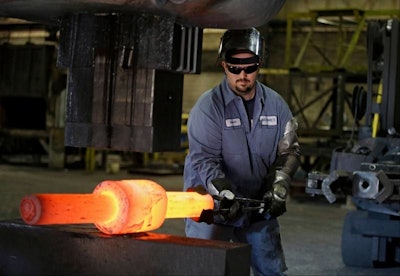
A manufacturing group predicts the U.S. industrial sector will grow at a faster rate than the national economy as a whole during the next two years.
Further manufacturing growth, however, is likely to be hampered by further increases in the nation's trade deficit.
Dan Meckstroth, vice president and chief economist of the Manufacturers Alliance for Productivity and Innovation, said Thursday the group expects the trade deficit to grow from $754 billion in 2014 to about $840 billion this year, and again to about $880 billion in 2016.
"That slows the growth rate of overall manufacturing," Meckstroth said.
Meckstroth attributed the projected widening gap between U.S. imports and exports to a rapidly strengthening U.S. dollar. Although that reflects the relative strength of the country's economy, it also makes U.S.-made goods more expensive in foreign markets.
"The U.S. economy is growing at a reasonably moderate rate, but we look strong compared to the rest of the world," Meckstroth said.
Other manufacturing groups have pointed to currency manipulation as a key factor in the U.S. trade deficits, particularly with China and Japan.
Meckstroth said consumer spending was the primary driver of recent economic growth, and although most of that momentum stemmed from strong hiring growth, the "collapse" of oil prices in recent months will also spur that spending going forward. He equated Americans' savings at the gas pump to “an $80 billion tax cut.”
MAPI expects 3.7 percent growth in the manufacturing sector this year, with 3.6 percent growth to follow in 2016. That’s ahead of projections for the country’s gross domestic product — 3 percent growth in 2015 and 2.7 percent in 2016 — but behind the 3.9 percent average in manufacturing sector growth in recent years.
Pent-up demand for vehicles, as well as recovery in the housing sector, will help make up for the issues with U.S. exports, Meckstroth said.
Meckstroth also predicted the country would be at “basically full employment” — an unemployment rate of less than 5 percent — by the end of 2016. He estimated manufacturing unemployment was already at that level in January when accounting for seasonal adjustments.
"It's a very tight labor market in manufacturing," Meckstroth said.
Numbers released earlier this week by the Federal Reserve showed a modest increase in U.S. factory output — a further reflection of stronger domestic demand and challenges in the export market.
ENTRIES OPEN: Establish your company as a technology leader. For 50 years, the R&D 100 Awards, widely recognized as the “Oscars of Invention,” have showcased products of technological significance. Learn more.






















